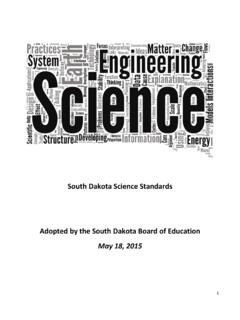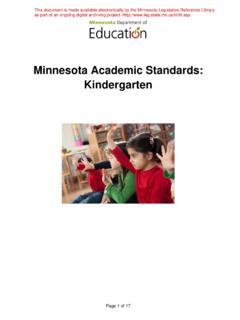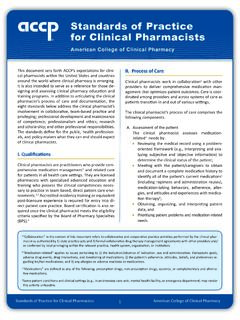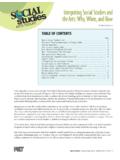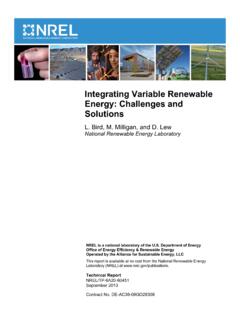Transcription of Integrating Cybersecurity and Enterprise Risk Management …
1 NISTIR 8286 Integrating Cybersecurity and Enterprise Risk Management (ERM) Kevin Stine Stephen Quinn Greg Witte R. K. Gardner This publication is available free of charge from: NISTIR 8286 Integrating Cybersecurity and Enterprise Risk Management (ERM) Kevin Stine Greg Witte Applied Cybersecurity Division Huntington Ingalls Industries Information Technology Laboratory Annapolis Junction, MD Stephen Quinn R. K. Gardner Computer Security Division New World Technology Partners Information Technology Laboratory Annapolis, MD This publication is available free of charge from: October 2020 Department of Commerce Wilbur L. Ross, Jr., Secretary National Institute of standards and Technology Walter Copan, NIST Director and Under Secretary of Commerce for standards and TechnologyNational Institute of standards and Technology Interagency or Internal Report 8286 74 pages (October 2020) This publication is available free of charge from: commercial entities, equipment, or materials may be identified in this document in order to describe an experimental procedure or concept adequately.
2 Such identification is not intended to imply recommendation or endorsement by NIST, nor is it intended to imply that the entities, materials, or equipment are necessarily the best available for the purpose. There may be references in this publication to other publications currently under development by NIST in accordance with its assigned statutory responsibilities. The information in this publication, including concepts and methodologies, may be used by federal agencies even before the completion of such companion publications. Thus, until each publication is completed, current requirements, guidelines, and procedures, where they exist, remain operative. For planning and transition purposes, federal agencies may wish to closely follow the development of these new publications by NIST.
3 Organizations are encouraged to review all draft publications during public comment periods and provide feedback to NIST. Many NIST Cybersecurity publications, other than the ones noted above, are available at on this publication may be submitted to: National Institute of standards and Technology Attn: Applied Cybersecurity Division, Information Technology Laboratory 100 Bureau Drive (Mail Stop 2000) Gaithersburg, MD 20899-8930 Email: All comments are subject to release under the Freedom of Information Act (FOIA). NISTIR 8286 Integrating Cybersecurity AND ERM ii This publication is available free of charge from: Reports on Computer Systems Technology The Information Technology Laboratory (ITL) at t he National I nstitute of standards and Technology (NIST) promotes t he economy and public welfare by providing technical leadership for the Nation s measurement and standards infrastructure.
4 ITL develops tests, test methods, reference data, proof of concept implementations, and technical analyses to advance the development and productive use of information technology. ITL s r esponsibilities i nclude t he development of Management , administrative, technical, and physical s tandards and guidelines f or the cost-effective security and privacy of other than national security-related information in federal information systems. Abstract The increasing frequency, creativity, and severity of Cybersecurity attacks mea ns that all enterprises should ensure t hat Cybersecurity risk is r eceiving appropriate attention within their Enterprise risk Management (ERM) programs. This document is i ntended to help individual organizations within an Enterprise improve their Cybersecurity risk information, which they provide as inputs t o their Enterprise s ERM processes t hrough communications and risk information sharing.
5 By doing so, enterprises and their component organizations can better identify, assess, and manage their Cybersecurity risks in the context of their broader mission and business objectives. Focusing on the use of risk registers to set out Cybersecurity risk, this document explains the val ue of rolling up measures of risk usually addressed at lower system and organization levels to the broader Enterprise level. Keywords Cybersecurity risk Management (CSRM); Cybersecurity risk measurement; Cybersecurity risk profile; Cybersecurity risk register (CSRR); Enterprise risk Management (ERM); Enterprise risk reg ister (ERR); Enterprise risk profile; risk appetite; risk tolerance. Acknowledgments The authors wish to thank all individuals, organizations, and enterprises that c ontributed to the creation of this document.
6 This i ncludes Donna Dodson, Nahla Ivy, Naomi Lefkovitz, Amy Mahn, Rodney Petersen, Victoria Yan Pillitteri, Ron Ross, and Adam Sedgewick of NIST; Larry Feldman, Heather Mills, Matthew Smith, and Daniel Topper of Huntington Ingalls I ndustries; Mat Heyman of Impresa Management Solutions; and Karen Scarfone of Scarfone Cybersecurity . Organizations and individuals who provided feedback on the public comment drafts include: Aon; the Association of Local Government Auditors; Paul Barham, Pat Nolan, Michael Vallone, and Christopher White of Booz Allen Hamilton; Consortium for Information and Software Quality; P. Bevill, G. Celestin, J. Chua, M. Creary, E. Flaim, K. Francis, C. Gordon, K. Isaac, C. Livingston, M. Merritt, M. Nighswander, K. Pannah, J. Prutow, and N. Rohloff of the Cyber-ERM Community of Interest; FAIR Institute; Forescout Technologies; Adam Bobrow of Foresight Resilience Strategies; the IT Risk Management Team of the Internal Revenue Service, Larry Clinton of the Internet Security Alliance; Gerald Beuchelt and Christine Wachter of LogMeIn; Mosaic 451; Alex Krutov of Navigation Advisors; Ismael Garcia of the Nuclear Regulatory Commission; Kelly Hood and Tom Conkle of Optic Cyber Solutions; John Kimmins of Palindrome; Profitabil-IT; Dick Brooks of Reliable Energy Analytics; Jack Freund of RiskLens; Marshall Toburen of RSA Security; Paul Rohmeyer of Stevens Institute of Technology; The Open Group; Rob Arnold of Threat Sketch; Ashley P.
7 Moore, and Nnake Nweke of the Agency for Global Media; Air Force; Department of Defense; NISTIR 8286 Integrating Cybersecurity AND ERM iii This publication is available free of charge from: Department of Education; Department of Energy; Department of Health and Human Services; Department of Homeland Security - Cybersecurity and Infrastructure Security Agency; Navy; other individuals include Simon Burson; Norman Marks; Ellen Swanson; and, Douglas Webster. Audience The primary audience for this publication includes both federal government and non-federal government Cybersecurity professionals at all levels who understand Cybersecurity but may be unfamiliar with the details of Enterprise risk Management (ERM). The secondary audience includes both federal and non-federal government corporate officers, high-level executives, ERM officers and staff members, and others who understand ERM but may be unfamiliar with the details of Cybersecurity .
8 All readers are expected to gain an improved understanding of how Cybersecurity risk Management (CSRM) and ERM complement and relate to each other as well as the benefits of Integrating their use. Trademark Information All registered trademarks and trademarks belong to their respective organizations. Document Conventions The term step or steps is used in multiple frameworks and documents. If the term step is referring to anything other than the meaning from the ERM Playbook from Figure 2, it will be preceded by a document or framework to differentiate its context ( , NIST Cybersecurity Framework Step 1: Prioritize and Scope .) For the purposes of this document, the terms Cybersecurity and information security are used interchangeably. While technically different in that information security generally is generally considered to be all encompassing including the Cybersecurity domain the term Cybersecurity has expanded in conventional usage to be equivalent to information security.
9 Likewise, the terms Cybersecurity Risk Management (CSRM) and Information Security Risk Management (ISRM) are similarly used interchangeably based on the same reasoning. Patent Disclosure Notice NOTICE: The Information Technology Laboratory (ITL) has requested that holders of patent claims whose use may be required for compliance with the guidance or requirements of this publication disclose such patent claims to ITL. However, holders of patents are not obligated to respond to ITL calls for patents and ITL has not undertaken a patent search in order to identify which, if any, patents may apply to this publication. As of the date of publication and following call(s) for the identification of patent claims whose use may be required for compliance with the guidance or requirements of this publication, no such patent claims have been identified to ITL.
10 No representation is made or implied by ITL that licenses are not required to avoid patent infringement in the use of this publication. NISTIR 8286 Integrating Cybersecurity AND ERM iv This publication is available free of charge from: Executive Summary All types of organizations, from corporations to federal agencies, face a broad array of risks. For federal agencies, the Office of Management and Budget (OMB) Circular A-11 defines risk as the effect of uncertainty on objectives [1]. The effect of uncertainty on Enterprise mission and business objectives may then be considered an Enterprise risk that must be similarly managed. An Enterprise is an organization that exists at the top level of a hierarchy with unique risk Management responsibilities. Managing risks at that level is known as Enterprise risk Management (ERM) and calls for understanding the core risks that an Enterprise faces, determining how best to address those risks, and ensuring that the necessary actions are taken.










